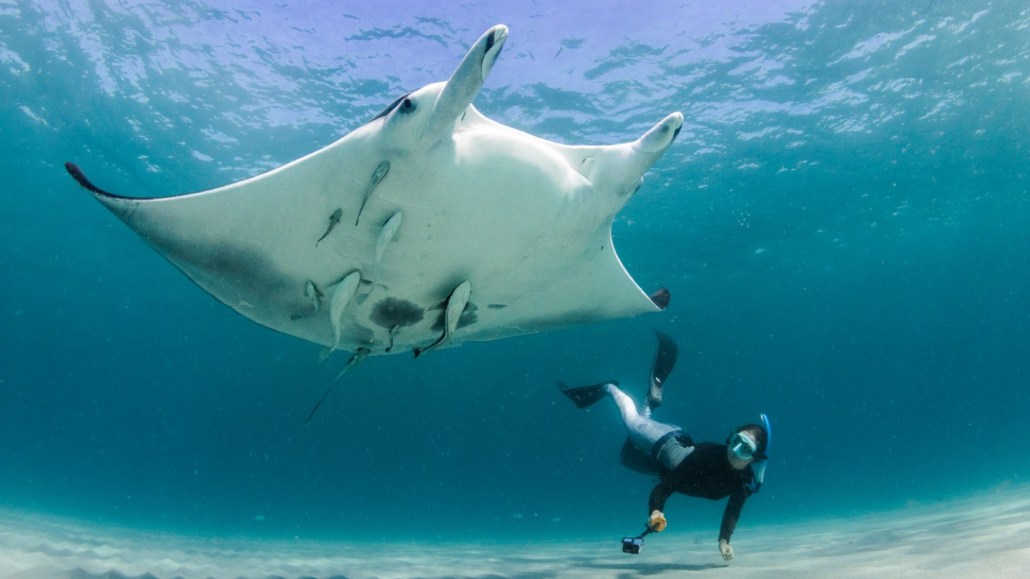This marine biologist is on a mission to save endangered rays
Figuring out where the enigmatic creatures mate and migrate is key to their conservation

Marine biologist Jessica Pate swims alongside an oceanic manta ray. Pate and colleagues recently discovered the first known manta ray nursery in Florida waters — and the third known nursery globally.
Bryant Turffs
- More than 2 years ago
The first time Jessica Pate swam beside a manta ray off Florida’s southern coast, the 8-foot-wide fish flipped belly-up and slowed to watch her. “I was kind of obsessed after that,” Pate says. The marine biologist was so hooked that she founded the conservation nonprofit Florida Manta Project and has dedicated the last seven years to studying mantas and their kin.
Her work is paying off. She and her colleagues have since discovered the first known manta nursery in Florida’s waters. Plus, the nonprofit launched an outreach campaign, based on surveys of local anglers, to encourage fishing practices that keep mantas safe.
Now Pate and her colleagues have learned that hundreds of sicklefin devil rays — an elusive cousin of mantas — also call the western Atlantic and Gulf of Mexico home, her team reports April 24 in the Journal of the Marine Biological Association of the United Kingdom.
Mantas and devil rays are both mobula rays, a genus that includes nine species, nearly all of which are listed as endangered by the International Union for the Conservation of Nature. That’s partly because these rays have slow reproductive cycles and typically produce just one pup per pregnancy, Pate says, and partly because the animals are susceptible to injury from boat strikes or entanglement in fishing gear.
Before Pate began studying oceanic mantas (Mobula birostris) off Florida, there was only one published study of sightings in the region. “There’s just so little awareness that manta rays are present,” she says. That makes instituting effective conservation measures difficult, because researchers know so little about the rays, such as population numbers or where they mate.
To fill knowledge gaps and raise the public profiles of manta rays in the western Atlantic, Pate conducts aerial drone surveys, gathers accounts of citizen sightings and spends countless hours tagging, tracking and measuring the creatures.
Those efforts led to the discovery a manta ray nursery off the coast of southern Florida. Not only is it the first found in the area, it’s also the third nursery ever found globally, the team reported in 2020 in Endangered Species Research. But its located in a heavily populated coastal area, where recreational fishing is popular — and a threat to rays (SN: 8/2/21).
Pate has seen several mantas with missing fin tips from entangled fishing lines, as well as “mantas that look like Christmas trees” with wings covered in jigs and lures. A survey of nearly 200 recreational anglers in Palm Beach County, Fla., found that that just two out of three could identify a manta ray, and even fewer knew how to prevent accidentally hooking one, Pate and colleagues reported in the June 2021 Aquatic Conservation.
However, 98 percent of surveyed anglers supported protecting the rays. The Florida Manta Project has since launched an outreach campaign that aims to build awareness of best practices, such as keeping an eye on the water while fishing and reeling in fishing lines until mantas have safely passed by.
Sometimes, though, what appears to be a manta might be one of its relatives. In 2018, a diver sent Pate a photo of a manta that turned out to be a sicklefin devil ray (M. tarapacana) — the first confirmed sighting of this species in the western Atlantic Ocean. Sicklefin devils are similar in size and shape to mantas, but they tend to be a golden-brown instead of black.
The photo had Pate wondering how many past manta sightings had in fact been devil rays. An analysis of aerial surveys and fisheries observation data collected from 1996 to 2022 turned up 361 sicklefin devils in the western Atlantic and Gulf of Mexico.
Because devil rays have been so understudied, “there are still huge knowledge gaps in their biology, ecology and life history,” says ecologist Joshua Stewart of Oregon State University’s Marine Mammal Institute in Newport. That makes it challenging to create management strategies that might help conserve the species. Research like Pate’s is essential for supporting “science-based conservation,” he says. It helps uncover “the movements and habitat use of these species in regions where they may be exposed to human impacts.”
Pate hopes that her team’s continued efforts will help protect majestic mantas and their cousins, she says, by making the rays “as iconic and recognizable as manatees and sea turtles.”






